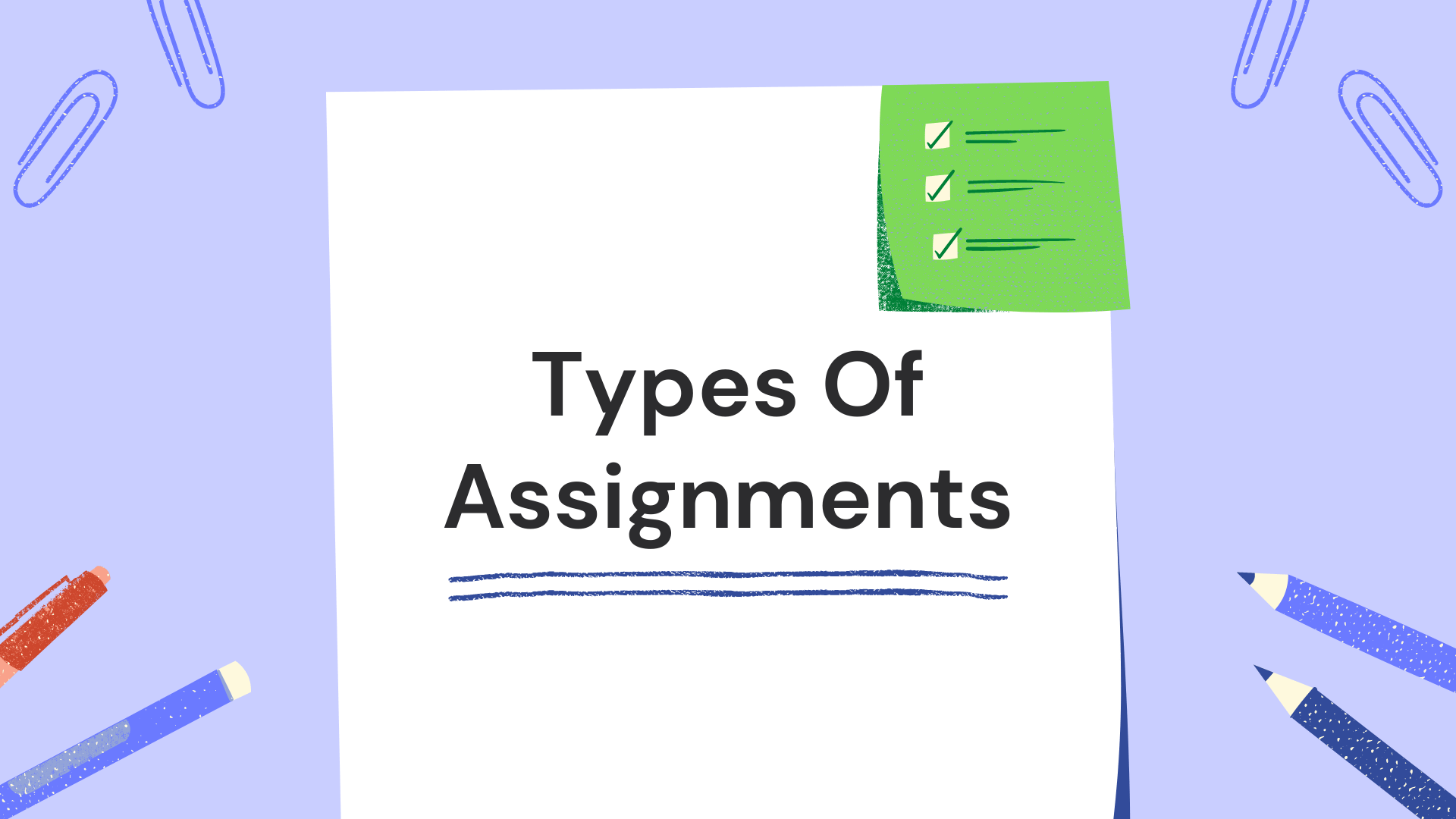Types Of Assignments: How Not To Get Lost In The Variety Of Writing Tasks
Table of Contents

Throughout their study, people should deal with numerous writing assignments. They can be of different structure, length, and requirements in general. But what is an assignment actually? It’s a writing task given to students to enhance their knowledge in the course or particular subject. Commonly, it’s a sort of homework where the learners should demonstrate not only how well they understand the data. It’s essential to think critically and closely follow the structure in the scholarly tasks. Usually, they are the same: essays or reports, but not always. The deeper you study the subject, the more types of assignments you find out about.
University Assignment: Distinct Types and Formats
Here you’ll find general information about types of assignment. Be aware that your teachers can have their own requirements for particular tasks. It’s better to clarify all the moments before you start dealing with your homework than to realise you did something wrong too late. The catch is that if students have great ideas but don’t follow the structure, they won’t get high marks. In order not to trip yourself up, you’d better know the main nuances of each assignment type. Also AssignmentBro can help with university assignment
Your assignment can be completed in 3 hours!
Has your deadline come quicker than you expected? No worries! We have what you need – a 3-hours deadline option! All features available for any other order applied, including:
- 100% original assignment
- Free formatting and reference list
- 24/7 online support
Essays
Probably the most “popular” assignment amongst others. Even university professors write such papers. That’s why the requirements for the student’s essay are pretty high. This task needs a profound argument and great explanations. The system of the essay is rather simple. It consists only of three parts:
- Introduction. This piece should call all the reader’s attention. That’s why the beginning of your essay must be catchy and impressive to make your teacher read your papers “from top to bottom”.
- Main body paragraphs. Here writers illustrate their ideas and provide strong arguments to substantiate them. It’s a sort of discussion monologue where you should convince your reader that your point of view is the only correct one.
- Summarising. In this part, you jump to the conclusion and summarise all your previous thoughts and ideas.
Reports
Reports are usually made to illustrate some significant points of the specific situation, process, or project. They require precise disclosure of information and formal structure with headings and subheadings. Unlike the essay, the report is more objective and needs more facts to be mentioned. This type of assignment can have several structures, but the standard one contains 7 parts:
- Title. Depending on the report’s size, the title can be either short or long. Accordingly, include only your name and date or, additionally, the list of contents and explanations of some terms.
- Summary. The most important part of your papers. It’s better to insert all the necessary information here. The teacher always browses the summary closely and often skims all the other parts.
- Introduction. Here the students have to clarify why they put up with a certain situation. Also, write here definitions of the terms if you didn’t do that in the title.
- Body. The “heart” of the report. Divide this part into small ones and make the information easy to read. If possible, provide the most significant data in the beginning.
- Conclusion. The verdict of your papers. Formulate it with no complicated terms.
- Recommendations. Here authors give some pieces of advice about the problem, describing in the report.
- Appendices. This part consists of specialised features to back up your conclusion.
For example you can buy lab report at our service.
Case studies
A case study is a complete analysis of some problems, for instance, in business or marketing. Students should provide real examples from life and analyse them in order to come to the best proper solution. A case study assignment requires deep immersion and great arguments from the author. Students often ask for assignment help with these distinct papers. Structure of the case study is somehow similar to the reports:
- Brief illustrative opening announcement.
- Formulation of the problem and its impact.
- Main body with all the data and your work process.
- Presentation of your own personal ideas which can help in solving the problem.
- Analysis of the questions.
- Your statements.
- Completing assertion.
Don’t forget that at AssignmentBro you can get case study writing help in a few clicks.
Reviews
It’s a form of assessment where students analyse certain material and criticise it. Comments can be either positive or negative. In both cases, the author should provide an objective assessment of the book, film, article, etc. The structure of the review is almost always the same:
- Introduction. This part contains from one to three paragraphs, depending on how long your review is. It declares the purpose of these papers and the author’s thought about the text being analysed.
- Summary. Inform how your documents are organised and put here the leading points of the text.
- Critique. Analyse the text objectively and provide the reader with the advantages and disadvantages of it. Make sure you use all the needed criteria in your estimation. Support your statements with other reliable sources.
- Conclusion and references. Sum up your review and provide citation sources you used while writing.
Abstracts
It’s like a smaller version of the academic papers. Here, students must provide key information about their work in a concise and accessible form in order to explain it even to people who have not read any additional sources. But how to structure abstracts correctly? Check the best possible way:
- Motive. Explain why you picked this particular problem and how it is related to your area of study.
- Problem. Specify the dilemma you’re depicting in your academic work and give your main argument.
- Strategy. Define your methods, shortly write your supporting arguments and mention sources you’ve used.
- Summarising. Sum up your outcomes.
- Conclusion. Make a deduction and mention why the problem you took is crucial one more time.
How to write a university assignment? Just follow the structure and mind all your teacher’s requirements!


 Log In
Log In
